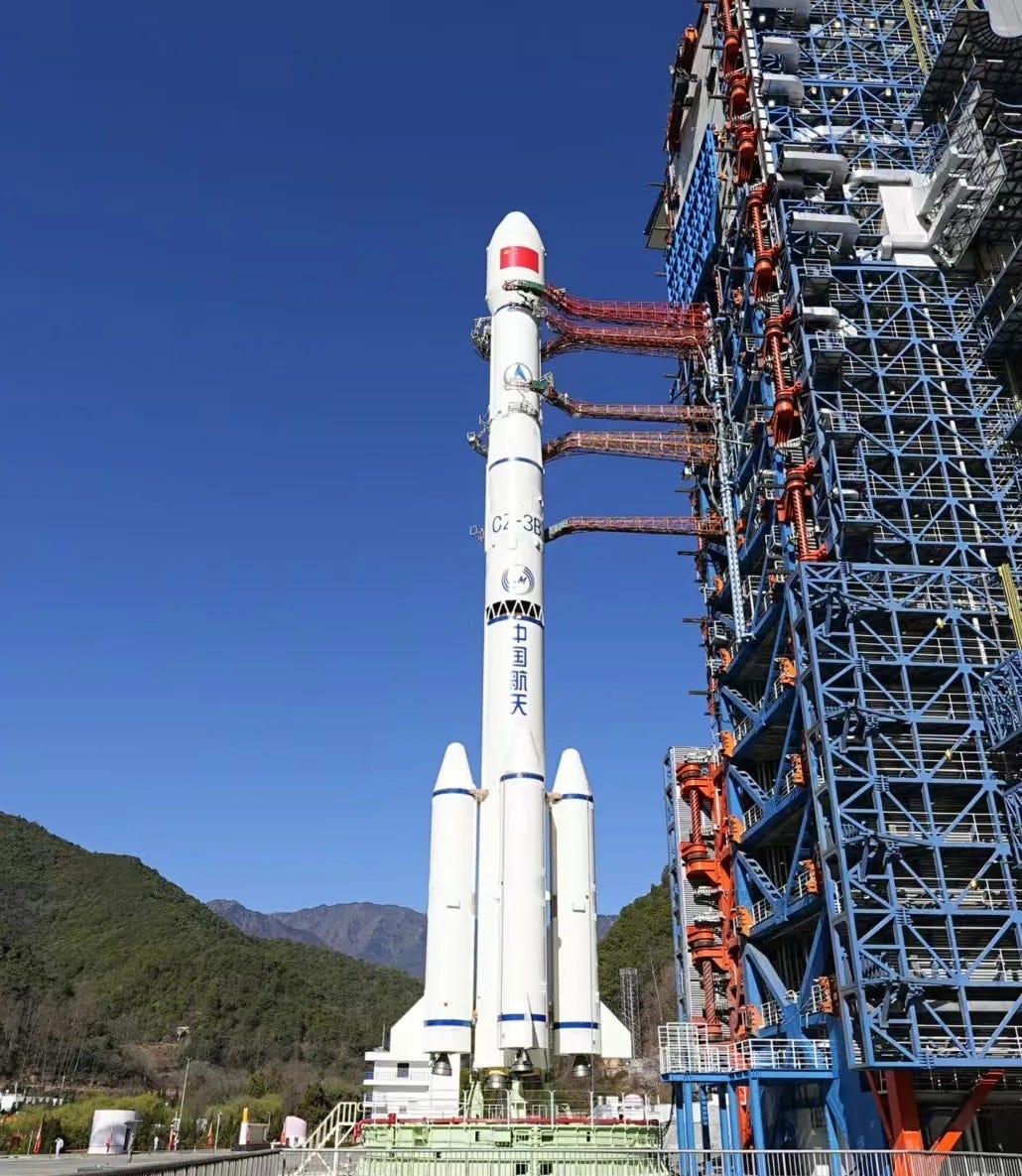Launch Cadence Grows for China's Geostationary Workhorse [Long March 3B/E]
A new TJSW satellite is headed out to geostationary space thanks to a Long March 3B/E.
A Long March 3B/E has blasted off from Launch Complex 3 at the Xichang Satellite Launch Center at 01:17 am China Standard Time on March 10th (or 17:17 pm Universal Coordinated Time on March 9th), carrying a single satellite out to a geostationary transfer orbit.
Atop of the Long March 3B/E was the TJSW-15 satellite (通信技术试验卫星十五号), called Communication Technology Experimental Satellite-15 in English. This spacecraft has been developed by the Shanghai Academy of Spaceflight Technology, with its uses including satellite communications, radio, television, and data transmission, as well as testing and verification for multi-band high-speed throughput communications technology.
This year the Long March 3B/E is aiming to rapidly increase its launch cadence, said to be enabled through continuous optimizations to vehicle production, testing, launch preparations, and team training. After today’s launch, the China Academy of Launch Vehicle Technology shared:
“As the single launch vehicle with the most launches in China's aerospace industry, the Long March 3B rocket has gone through a large number of launch missions, and its technical maturity and reliability are obvious to all. However, the model team has always insisted on technological innovation and reliability improvement, and continuously improved the overall performance and competitiveness of the rocket. Some of the onboard products of the present launch vehicle have been unified with those of the Long March 7A launch vehicle, and have been optimized with the innovative technologies applied by the new generation of launch vehicles. Meanwhile, the level of generalization of the onboard products has been further strengthened to improve the efficiency and reliability of the rocket production, and to push forward the reduction of cost and increase of efficiency.”
If there are any problems with this translation please reach out and correct me.
So far four Long March 3B/E’s have launched this year, with another expected to take flight in March. Additionally, toward the end of last year, the China Academy of Launch Vehicle Technology stated that they were aiming to launch the Long March 3B/E over a dozen times per year, with approximately fifteen days between missions. The last mission for the rocket was just two weeks ago as well.
Today’s mission was the 105th launch of a Long March 3B vehicle, and the 562nd launch of the Long March launch vehicle series. This was also the 11th launch from China in 2025.
Check out the previous Long March 3B/E launch
New Communications for the Belt and Road [Long March 3B/E Y101]
Just barely over a month after its previous mission, a Long March 3B/E lifted off from Launch Complex 2 at the Xichang Satellite Launch Center at 20:11 pm China Standard Time, or 12:11 pm Universal Coordinated Time, on February 22nd. For this launch, a single satellite was being delivere…
What is the Long March 3B/E?
This section is for those less familiar with China's Long March series of launch vehicles.
The Long March 3B is an older-generation geostationary orbit workhorse of the China Academy of Launch Vehicle Technology. The first two stages and four boosters of the rocket burn Dinitrogen Tetroxide and Unsymmetrical Dimethylhydrazine, with liquid hydrogen and liquid oxygen in the third-stage.
Over the rocket's almost twenty-eight-year launch history, two versions of the vehicle have flown, the 3B and 3B/E. Since 2012 only the 3B/E variant has flown due to its increased payload capacity. The payload capacity of the launch vehicle is currently as follows:
11,500 kilograms to low Earth orbit
7,100 kilograms to a sun-synchronous orbit
5,500 kilograms into a geostationary transfer orbit
2,000 kilograms into geostationary orbit
The first-stage is powered by four YF-21C engines that burn Dinitrogen Tetroxide and Unsymmetrical Dimethylhydrazine to generate 302 tons of thrust, while the boosters are powered by one YF-25 engine burning the same fuel to generate 72 tons of thrust each. Combined the four boosters and first stage generate a thrust of 590 tons. The second stage is powered by one YF-22E and four YF-23F vernier engines that also burn Dinitrogen Tetroxide and Unsymmetrical Dimethylhydrazine to generate 81 tons of thrust. The third-stage is powered by two YF-75 engines that burn liquid hydrogen and liquid oxygen to generate 17 tons of thrust.
On the launch pad, the Long March 3B/E is 56.3 meters tall and weighs 458,970 kilograms when fully fuelled. The first and second-stage have a diameter of 3.35 meters, while the third-stage has a diameter of 3 meters, along with the four boosters diameter of 2.25 meters, and the fairing has a diameter of 4.2 meters.
So far every Long March 3B launch has occurred from the Xichang Satellite Launch Center, in the south of Sichuan province.





![New Communications for the Belt and Road [Long March 3B/E Y101]](https://substackcdn.com/image/fetch/$s_!zVvN!,w_1300,h_650,c_fill,f_auto,q_auto:good,fl_progressive:steep,g_auto/https%3A%2F%2Fsubstack-post-media.s3.amazonaws.com%2Fpublic%2Fimages%2Fdae5d5a7-c563-4c46-b43b-f7951dd044a3_3569x2176.jpeg)
